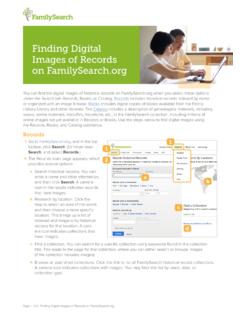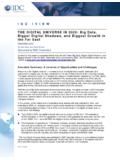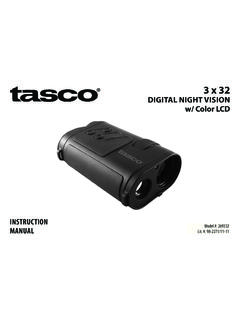Transcription of DICOM Structured Reporting Overview - RSNA
1 DICOM Structured Reporting Overview Harry Solomon GE Healthcare RSNA Industry Forum on Structured Reporting Results DICOM Structured Reporting The scope of DICOM SR is the standardization of Structured data and clinical observations in the imaging environment. SR objects record observations made for an imaging- based diagnostic or interventional procedure, particularly those that describe or reference images, waveforms, or specific regions of interest. Most important in the stages before report creation 2. Why do you need to know about DICOM SR? DICOM SR is the standard to exchange Structured data produced in the course of image acquisition or post-processing, where: Leveraging the DICOM infrastructure is easy and desirable Results should be managed with other study evidence Replaces legacy kludges Manually transcribed worksheets, screen scrapes from analysis apps, one-off integrations Examples Sonographer measurements Computer-aided detection results QC notes about images Radiation dose reports image exchange manifests 3.
2 DICOM SR is not Structured Data Entry . Hierarchical pull-down menus for results capture or report creation is often denoted Structured Reporting . DICOM does not standardize applications or data entry techniques Structured data entry is a valuable means of creating SR content in certain circumstances Standard SR templates and value sets can support the implementation of Structured data entry forms 4. Key Aspects of DICOM SR. SR documents are encoded using DICOM standard data elements and leverage DICOM network services (storage, query/retrieve). SR uses DICOM Patient/Study/Series information model (header), plus hierarchical tree of Content Items . Extensive use of coded nomenclature Allows use of vocabulary/codes from non- DICOM sources (especially LOINC and SNOMED, possibly RadLex).
3 Templates define content constraints for specific types of documents / reports 5. SR Content Item Tree Arrows are parent-child relationships Contains, Has properties, Inferred from, etc. Root Content Item Content Items are units of meaning . Document Container Text, Numeric, Code, image , Spatial coordinates, etc. or units of structure Content Item Content Item Content Item Container Content Item Content Item Content Item Content Item Content Item Content Item 6. DICOM SR Example Encoded with DICOM attributes External codes (LOINC). Measurements with Hierarchical tree related method and structure statistical properties The Problem of SR Flexibility A document creator can put in anything in any structure A document reader must handle every possible document Need to constrain the SR content to enable meaningful receiving applications Structure Content 8.
4 SR Templates Like IODs, but for SR content Define attributes (concepts), required/optional, and allowed values Specify hierarchical structure of sections and subsections (containers). Specified for a variety of uses, often in conjunction with specialty societies OB/GYN, vascular, echo, and IVUS ultrasound X-ray, CT, and MR angiography Mammo, chest, and colon computer-aided detection Radiation dose 9. DICOM SR Object Classes General use Enhanced and Comprehensive - Text, coded content, numeric measurements, spatial and temporal ROI. references (any template). CAD - Automated analysis results (SOP Class per CAD. template). Key Object Selection (KO) - Flags one or more images Purpose ( for referring physician , for surgery , ) and textual note Used for key image notes and image manifests (in IHE profiles).
5 Procedure Log - For extended duration procedures ( , cath). Radiation Dose Report - Projection X-ray; CT. 10. Summary DICOM SR is the standard for exchange of Structured data / clinical observations in the imaging environment DICOM SR leverages existing imaging infrastructure and toolkits DICOM SR is constrained by templates and SOP Classes to improve interoperability for specific use cases 11. For more information DICOM Standard Part 3: SR SOP Classes (Section ), SR Modules (Section ). Part 16: Templates (Annex A). David Clunie's introduction to DICOM SR. IHE use cases for DICOM SR. Radiology Technical Framework Vol 1: Key image Note (Section 8), Evidence Documents (Section 14).
6 Cardiology Technical Framework Vol 1: Evidence Documents (Section 7). 12.






